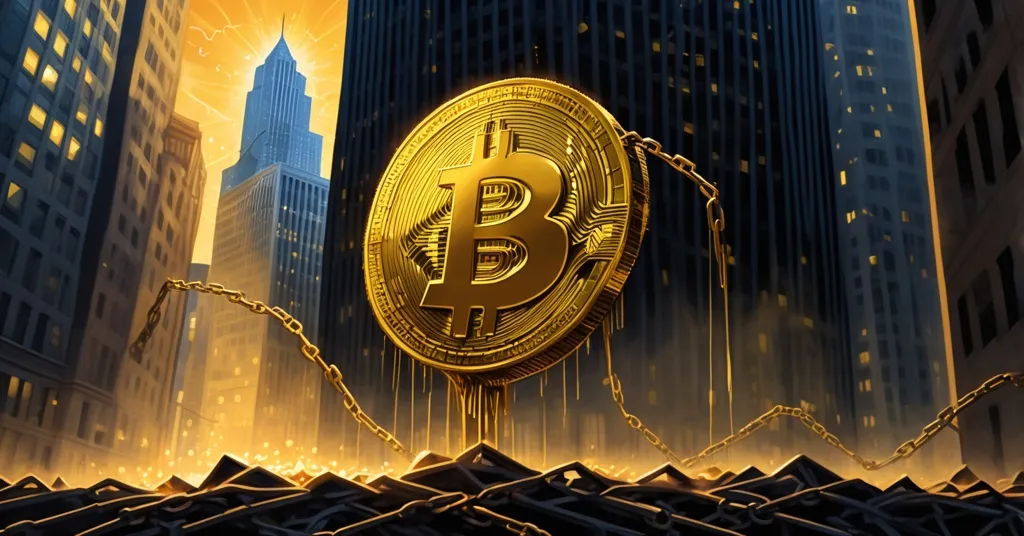Bitcoin’s Betrayal: Has BTC Lost Its Fight to End the Fed?

End the Fed: Has Bitcoin Betrayed Its Revolutionary Roots?
Bitcoin emerged as a radical idea to shatter the grip of centralized financial systems like the Federal Reserve, promising a future where money is controlled by the people, not bureaucrats. Yet, over a decade later, has Bitcoin (BTC) strayed so far from its rebel origins that it’s now just another toy for Wall Street? Let’s dive deep into Bitcoin’s journey from peer-to-peer cash to institutional darling, explore whether alternatives like Bitcoin SV (BSV) can reclaim the fight to End the Fed, and ask the hard questions about what it’ll really take to disrupt the status quo.
- Bitcoin’s Shift: From a tool to replace fiat currency to a speculative “digital gold” asset.
- Institutional Capture: ETFs and banks pulling BTC into traditional finance’s orbit.
- BSV’s Case: A scalable fork aiming to revive Bitcoin’s original transactional vision.
The Rebel Dream: Bitcoin vs. the Federal Reserve
I remember stumbling upon Bitcoin back in 2012, not as some tech gimmick, but as a full-on assault on the Federal Reserve. The Fed, with its relentless money printing and inflation—essentially a sneaky tax on savings—was the villain. Satoshi Nakamoto’s 2008 white paper laid out a vision for Bitcoin as a peer-to-peer electronic cash system, a way to trade online without banks or governments meddling. It was sound money, a direct jab at fiat currency’s predatory devaluation, as detailed in its historical origins. The rallying cry was simple: dismantle central banking.
That fire seems like a fading ember now. Bitcoin (BTC) isn’t circulating as everyday cash for most; it’s hoarded in cold wallets or gambled on by speculators hoping for the next price spike. Worse, its narrative has been hijacked—rebranded as “digital gold,” a reserve asset for the elite rather than a lifeline for the everyman. Since the U.S. approved Bitcoin Exchange-Traded Funds (ETFs) in 2021, giants like BlackRock have scooped up massive chunks of BTC supply. Banks, once crypto’s arch-nemesis, now legally custody it with the Fed’s own nod. If this isn’t irony, I don’t know what is.
“If Bitcoin becomes little more than a highly volatile, tightly held reserve asset controlled by hedge funds and ETFs, it will never ‘end the Fed.’ It will join the Fed.”
This isn’t a minor detour; it’s a betrayal of Bitcoin’s core mission. Venture capitalists, big banks, and even PayPal mafia alumni have steered BTC’s path, with firms like Blockstream often criticized for pushing it toward a passive settlement layer—think of it as a slow, expensive backbone for big transactions—rather than a usable, everyday currency, a shift explored in historical debates on Bitcoin’s direction. The result is damning: Bitcoin isn’t challenging the Fed; it’s being absorbed into its ecosystem, just another shiny asset for the financial machine.
The Hoarding Curse: Bitcoin as a Speculator’s Game
Let’s cut through the hype and look at how Bitcoin is actually used—or more accurately, not used. Across BTC, Bitcoin Cash (BCH), and even Bitcoin SV (BSV), most coins aren’t moving. They’re locked away, treated as speculative bets or digital lottery tickets by HODLers waiting for prices to “moon.” ETF custody has turbocharged this problem, with vast amounts of BTC supply sitting in institutional vaults, far from any real monetary purpose. If you’re not spending it on a coffee or paying rent, how the hell is it supposed to rival the dollar?
“The original vision for Bitcoin was not a new class of investment for the elite. It was a peer-to-peer electronic cash system that could compete with fiat in everyday transactions.”
The irony stings. A currency that doesn’t circulate isn’t a currency—it’s a damn collectible. While BTC price pumps might make holders feel like geniuses, they do absolutely nothing to shake central banking’s foundations. Jerome Powell and his Fed cronies aren’t sweating over a volatile asset that’s mostly a speculative sideshow. For Bitcoin to pose any threat, it needs to be spent, not stashed, a concern echoed in discussions about whether it has lost its revolutionary edge.
Bitcoin SV: Reviving Satoshi’s True Intent?
This is where Bitcoin SV (BSV) enters the fray, a fork of Bitcoin that claims to honor the original blueprint. Unlike BTC’s limited block sizes, which bottleneck transaction speed and jack up fees, BSV focuses on scalability with unbounded block capacity—think of it as widening a highway to let millions of cars through at once. It boasts over 5,000 transactions per second (TPS) with fees as low as $0.0000005, and has processed over 3.5 billion transactions total, including 125 million in 2023 alone. Born from a 2018 split with Bitcoin Cash over scaling disputes, BSV aims to be the network for real-world commerce—micro-payments, tokenized assets, you name it, as showcased in recent updates on BSV’s scalability and use cases.
BSV isn’t just about raw numbers; it’s building an ecosystem. Tools like 1Sat Ordinals enable atomic ownership, essentially letting you tokenize and trade assets with pinpoint control. MNEE, a stablecoin on the 1Sat protocol, acts like a steady digital dollar for buying and selling without wild price swings. Platforms like sCrypt allow developers to craft smart contracts—automated agreements coded on the blockchain—while BitcoinSchema.org standardizes financial building blocks like tokens and decentralized marketplaces. These are real pieces for a BSV-native economy that could rival centralized banking, supporting lending, DeFi (decentralized finance), and more without middlemen or shady exchanges.
BSV is also making waves where fiat fails hardest. In Latin America, for instance, it’s powering stablecoin projects in places like Argentina, where hyperinflation—over 200% in recent years—makes pesos a cruel joke. Events like MERGE Buenos Aires showcase BSV’s role in blockchain innovation for unstable economies. Could this be the grassroots uprising Bitcoin was always meant to ignite?
Hold the applause, though. BSV carries baggage—its link to Craig Wright, who controversially claims to be Satoshi Nakamoto (a claim most in the crypto world roll their eyes at), taints its rep. Limited exchange support and community skepticism mean it’s no guaranteed savior. Still, its obsession with utility over speculation offers a stark counterpoint to BTC’s Wall Street drift.
Bitcoin vs. Bitcoin SV: Scalability and the Fight Against Central Banking
To really grasp the divide, let’s compare the heavyweights. BTC’s network, while the most secure and globally recognized, handles a measly 7 TPS with fees often spiking to $10 or more during peak times—hardly ideal for buying a sandwich. BSV’s 5,000+ TPS and sub-cent fees scream practicality for everyday use. Ethereum, another major player, clocks around 15-30 TPS but shines in smart contract complexity, though its fees can also sting. BSV’s focus on raw throughput positions it as a transactional beast, but BTC’s unmatched brand and security keep it the king of recognition. The question is: do we want a fortress or a functional currency to overthrow fiat control, a debate further explored in community discussions on Bitcoin scalability?
Institutional Adoption: Progress or Surrender?
The Upside of Mainstream Bitcoin
While BSV grinds in the trenches, BTC’s institutional embrace sparks debate. On one hand, ETFs and bank custody—greenlit by U.S. regulators—bring serious liquidity and mainstream trust. This could onboard millions to crypto, normalizing digital assets and maybe even forcing central banks to rethink monetary policy. Some argue this influx of capital might indirectly fuel DeFi innovation or fund on-chain projects, creating a ripple effect of decentralization despite the centralized entry point. Regulatory clarity also signals a maturing market, which could pressure the Fed from within, as noted in analyses of central banking critiques versus Bitcoin.
The Centralization Trap
On the other hand, this integration screams danger. When custodians like BlackRock hold vast swaths of Bitcoin, power shifts back to the very elites Bitcoin was built to dethrone. There’s a real risk of BTC becoming just another Wall Street plaything, its value dictated by hedge fund whims rather than real utility. Community voices on platforms like Quora warn that crypto could face a brutal “downfall” like meme stocks if economic downturns hit, wiping out value overnight. Is this the revolution we fought for, or a surrender dressed as progress, a tension unpacked in studies on institutional impact?
“So no, Bitcoin isn’t ending the Fed. It’s being folded into its ecosystem.”
Broader Battlefield: Altcoins and the Fiat Fight
While Bitcoin and its forks dominate this discussion, let’s not ignore other players. Ethereum, with its robust smart contract ecosystem, powers countless DeFi apps that challenge fiat in unique ways—think decentralized lending or yield farming. Stablecoins like USDT and USDC offer fiat-pegged stability for real-world transactions, filling gaps BTC doesn’t. These altcoins carve out niches Bitcoin may never (and perhaps shouldn’t) touch, pushing the financial revolution on multiple fronts. Still, Bitcoin’s cultural weight keeps it at the heart of the “End the Fed” battle—its success or failure sets the tone for the rest, especially as ETFs and custody trends raise decentralization concerns.
Key Questions and Takeaways on Bitcoin’s Fight to End the Fed
- Has Bitcoin (BTC) abandoned its mission to dismantle central banking?
Mostly, yes—its pivot to a speculative reserve asset, controlled by institutions via ETFs and banks, strays far from the peer-to-peer cash dream, aligning it closer to traditional finance than rebellion. - Can Bitcoin SV (BSV) succeed where BTC is faltering in challenging the Fed?
It’s possible—BSV’s scalability and focus on real transactions match Satoshi’s intent more closely, but controversies and limited mainstream traction cast doubt on its reach. - Is institutional adoption of Bitcoin a net positive or negative for its revolutionary goals?
It’s a double-edged sword—liquidity and trust grow with ETFs and bank involvement, but centralization risks turn BTC into a financial instrument, undermining decentralization. - What’s the true path for crypto to overthrow fiat control?
Forget holding and praying for price surges; it’s about using Bitcoin or forks like BSV as real money for daily needs, building on-chain economies that make centralized banking irrelevant.
Historical Echoes: How Bitcoin’s Mission Evolved
To understand today’s crossroads, let’s rewind. Bitcoin’s early days—like its use on Silk Road for untraceable deals—screamed rebellion. Satoshi’s forum posts hammered home the need for money free of government overreach. But the 2017 scaling wars, splitting BTC and BCH over block size limits, exposed a rift: transaction utility versus store-of-value security. Blockstream’s influence cemented BTC’s conservative path, while forks like BSV pushed for massive throughput. Each step shaped where we stand now—BTC as a global name, but arguably a diluted threat to the Fed.
The Road Forward: Build or Bust
Here’s the brutal truth: no crypto—be it Bitcoin or BSV—will topple the Fed by rotting in wallets or ETF vaults. Disruption isn’t passive; it’s active. We need tools, ecosystems, and habits that make crypto a genuine fiat alternative. Whether BTC rediscovers its transactional grit or BSV scales to global utility, the focus must be usage, not speculation. Imagine a future where micro-payments on BSV power gaming economies, or BTC fees drop enough for everyday trades. That’s the pressure point, not price charts.
This fight isn’t just technical—it’s cultural. The crypto community must decide: are we here for quick riches or to rewrite finance’s rules? If it’s the latter, stop obsessing over candlestick graphs and start coding, spending, innovating. Join BSV dev communities, experiment with microtransactions, push for BTC fee solutions. Only then might we loosen the Fed’s stranglehold—not by begging for permission, but by making their system obsolete. Until that shift, “End the Fed” is just a catchy hashtag, not a revolution. So, what are we waiting for? Roll up your sleeves and let’s build.
“Want to end the Fed? Don’t buy BTC and wait for it to moon. Build something. Create value. Use Bitcoin as money. That’s the only path to structural change.”



